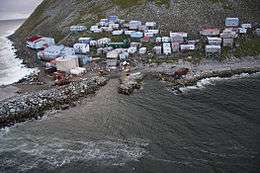Little Diomede Island
Little Diomede Island or “Yesterday Isle” (Inupiaq: Iŋaliq, formerly known as Krusenstern Island,[lower-alpha 1][3] Russian: Остров Крузенштерна, Ostrov Kruzenshterna) is an island of Alaska, United States. It is the smaller of the two Diomede Islands located in the middle of the Bering Strait between the Alaska mainland and Siberia.
| Native name: Iŋaliq | |
|---|---|
 The native Iñupiat village of Diomede/Inalik on Little Diomede Island | |
 Little Diomede | |
| Geography | |
| Location | Bering Strait |
| Coordinates | 65°45′15″N 168°55′15″W |
| Archipelago | Diomede Islands |
| Area | 2.8 sq mi (7.3 km2) |
| Highest elevation | 494 m (1,621 ft) |
| Administration | |
| Demographics | |
| Population | 115[1] (2010) |
| Pop. density | 48/sq mi (18.5/km2) |
| Ethnic groups | 96% Iŋaliq Iñupiaq Eskimo[2] |
| Additional information | |
| Time zone | |
Little Diomede's neighboring island, Big Diomede, is about 2.33 miles (3.75 kilometers) to the west, but is part of Russia and west of the International Date Line. Unlike its larger Russian neighbor, Little Diomede retains a permanent native population. As of the 2010 census, Little Diomede had a population of 115, down from its recorded peak of 178 in 1990.[4] The entirety of the island is in the City of Diomede (named Iŋaliq as well).[5] The island is not part of any organized borough, so some services are provided directly by the state. For census purposes, it is included in the Nome Census Area.
During the Cold War, the section of the border between the U.S. and the USSR separating Big and Little Diomede became known as the "Ice Curtain". In 1987, however, Lynne Cox swam from Little Diomede to Big Diomede (approx. 2.2 miles (3.5 km)) and was congratulated jointly by Mikhail Gorbachev and Ronald Reagan.[6]
Etymology
The Diomede Islands are named after Saint Diomedes. Danish-Russian navigator Vitus Bering (after whom the Bering Strait is named) sighted the Diomede Islands on August 16 (O.S., August 27 N.S.), 1728, the day on which the Russian Orthodox Church celebrates the memory of the saint.[7]
Its Inupiaq name Iŋaliq means "the other one" or "the one over there".[8]
Geography


According to the United States Census Bureau, the island has a total area of 2.8 square miles (7.3 km2), all of it land. On the western shore of the island is the village of Diomede, also known as Iŋaliq.
Little Diomede Island is located about 25 kilometers (16 mi) west from the mainland, in the middle of the Bering Strait. It is only 0.6 kilometers (0.4 mi) from the International Date Line and about 2.4 miles (3.9 km) from the Russian island of Big Diomede.
The highest point on Little Diomede Island is 494 meters (1,621 feet) (about halfway along the west coast, about 1.5 miles (2.4 kilometers) southeast of the village, facing the southern tip of Big Diomede).
There is a heliport, the Diomede Heliport, with regular helicopter flights. During the winter, the villagers carve a runway into the thick ice sheet so that bush planes can deliver vital products, such as medicine. Due to annual variations of the ice sheet, the runway changes position every year.
Climate
Summer temperatures average 40 to 50 °F (4–10 °C). Winter temperatures average from 10 to 6 °F (−12 – −14 °C) Annual precipitation averages 10 inches (250 mm), and annual snowfall averages 30 inches (76 cm). During summer months, cloudy skies and fog prevail. Winds blow consistently from the north, averaging 15 knots (17 mph; 28 km/h), with gusts of 60 to 80 miles per hour (97–129 km/h). The Bering Strait is generally frozen between mid-December and mid-June.[9]
Geology
The Little Diomede island is composed of Cretaceous age granite or quartz monzonite.[10][11] The location of the city is the only area which does not have near-vertical cliffs to the water. Behind the city and around the entire island rocky slopes rise at about 40° up to the relatively flattened top in 1,148–1,191 feet (350–363 m). The island has very scant vegetation.
In popular culture
Little Diomede was featured in the first episode of Full Circle with Michael Palin, a 1997 BBC documentary series in which the broadcaster Michael Palin traversed many of the countries of the Pacific Rim.[12] The Diomede Islands are also featured in the novel Further Tales of the City, by Armistead Maupin.
Notes
- Krusenstern Island may also refer to other places; see Krusenstern Island (disambiguation)
References
- Local Economic Development Plan for Diomede 2012-2017, citing 2010 U.S. census (and this was a decline since the 2000 census)
- Local Economic Development Plan for Diomede 2012-2017, citing 2010 U.S. census
- The American Local History Network Archived 2012-04-24 at the Wayback Machine
- Local Economic Development Plan for Diomede 2012-2017, citing 1990 U.S. census
- Local Economic Development Plan for Diomede 2012-2017
- "Lynne Cox swims into communist territory". History. Retrieved 7 August 2017.
- Russia.com Archived 2008-09-20 at the Wayback Machine
- Milepost (1990). Alaska Wilderness Milepost. Graphic Arts Center. p. 327. ISBN 978-0-88240-289-5.
name for the village is Inalik, meaning "the other one" or "the one over there
- Local Economic Development Plan for Diomede, 2012-2017( Archived 2016-12-02 at the Wayback Machine)
- Till, A. B., et. al., Bedrock Geologic Map of the Seward Peninsula, Alaska, and Accompanying Conodont Data, Pamphlet to accompany Scientific Investigations Map 3131, USGS
- Gualtieri, Lyn and Julie Brigham-Grette, The Age and Origin of the Little Diomede Island Upland Surface, Arctic, Vol. 54, No. 1 (March 2001) pp. 12–21
- "Palin's Travels - Full Circle". PalinsTravels.co.uk. Retrieved 8 March 2016.
External links
| Wikivoyage has a travel guide for Little Diomede. |
- Diomede Community Page
- Census 2000 information
- Diomede School
- You CAN see Russia from here! – Anderson Cooper 360